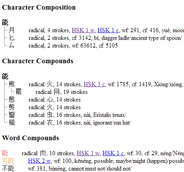I have seen this question asked a few times, so here's the best answer I am able to give.
- I have collected together and added English for some example sentences that demonstrate grammatical points for the HSK 1, HSK 2, and HSK 3. These example sentences can also be downloaded as flashcard files for use in software such as Pleco and StickyStudy.
- The excellent AllSet Learning Grammar Wiki has a page that classifies the grammatical points on the site into 6 levels. These seem to correspond roughly to the six HSK levels, so it would be a good idea to ensure you are familiar with the grammatical points in the appropriate levels.
- Another post on this site shows the contents page of the great grammar book Common Chinese Patterns 330 by Qin Xue Herzberg. I have classified the patterns by HSK level, and there are popup tooltips with information about the characters. The best way to use this list is to study the appropriate patterns from the book.
- The sample exams at the official HSK site chinesetest.cn has quite a few sample exams for each level; doing all of the exams is great practice at seeing the different ways grammatical points can occur.
- Some other grammar books that I own that are useful but don't have any information on the HSK level of each point specifically are: Basic Patterns of Chinese Grammar by Chen Ru, Modern Mandarin Chinese Grammar by Claudia Ross, Schaum's Outline of Chinese Grammar by Claudia Ross.
- These sites don't have much information on their suitability for HSK levels, but are a great resources: Chinese Grammar by Hugh Grigg (who also has an awesome blog), Oxford University's grammar notes, and these basic review slides at Rutgers are a great way to start.
- The HSK grammar books I have found tend to be focused on the 'Old' HSK, and so they might not match the New HSK too well. I have listed a few in case you are willing to try them (I haven't) Practising HSK Grammar by Zhang Jing, Essentials of HSK Grammar by Zhao Jing, HSK Grammar by Fu Yuping, Brushing Up Your Grammar for HSK by Dong Cui, HSK Grammar Guidebook by Han Zhigang
- I would love to find some more good books and resources for studying Chinese grammar- let me know if you have any suggestions


 RSS Feed
RSS Feed